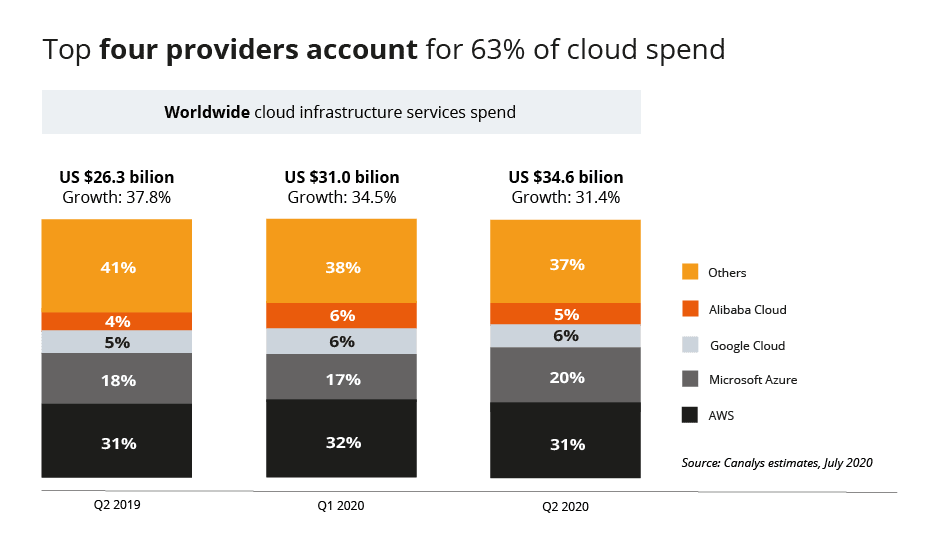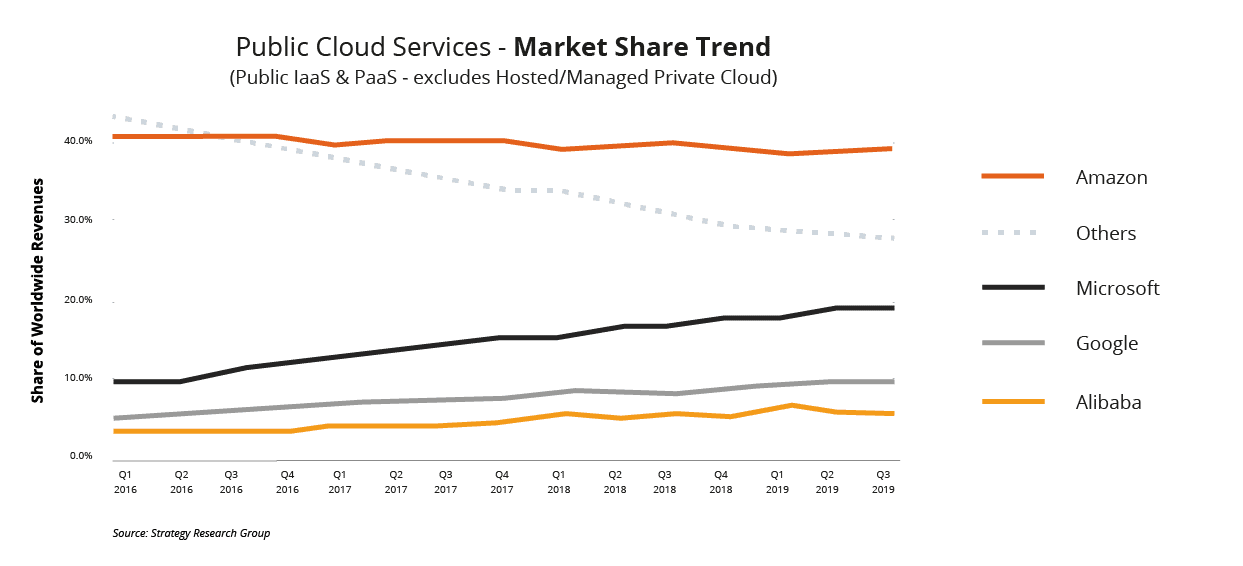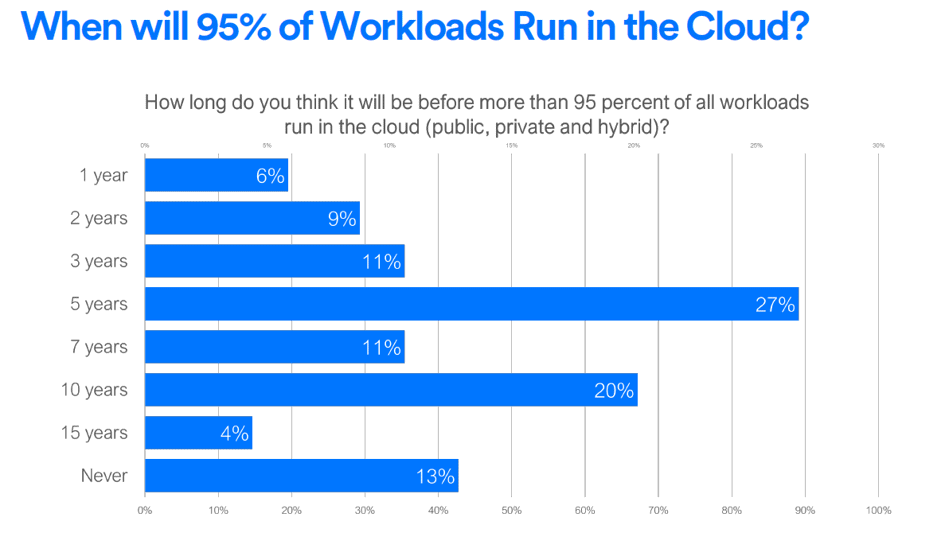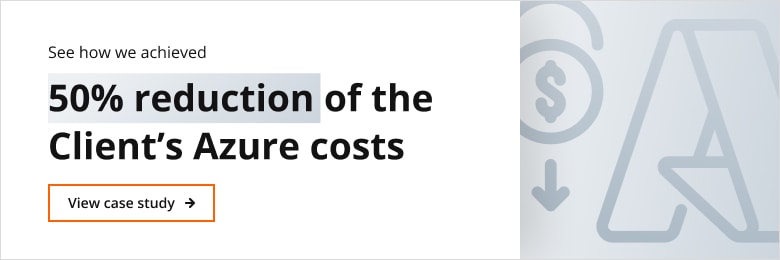
Cloud Market Share and Providers Comparison
The most prominent cloud service providers include Amazon Web Services, Google Cloud Platform, Microsoft Azure, and Alibaba Cloud. Each of these services does its best to gain new customers with an emphasis on enterprise-level organisations.
But which one is at the top right now? We’ll check it using data from business analyses, Google Trends, and the search volume per country.
Global Cloud market share: AWS vs Azure vs GCP vs Alibaba Cloud
The leading players in the cloud services industry are Google, Amazon, and Microsoft. Amazon’s AWS is, by far, the most popular, with about 31% market share of cloud services.
Above all, this means that, in the IaaS (Infrastructure as a Service in Cloud) segment, AWS gets as much as 50% of revenue. Microsoft Azure is second with 20%, and Google Cloud Platform takes third place with 6%. Bringing up the rear is Alibaba with another 6%. The market is quite unstable, though, with relatively a lot of fluctuations.
As one of the most dynamic industries, cloud services grow by about 30% annually.

Jeff Bezos explains the domination of the American giant AWS. Essentially, it results from the headstart Amazon got compared to its competitors:
AWS had the unusual advantage of a seven-year head start before facing like-minded competition. As a result, the AWS services are by far the most evolved and most functionality-rich.Jeff Bezos
While AWS is definitely the largest player on the market at this point in time, you can clearly see that Microsoft Azure and the smaller ones represented by Google and Alibaba are growing relatively rapidly.
It’s especially observable when looking at data from the last few years:

The relatively high interest in the lesser-known Alibaba Cloud is primarily the result of its strong position in China.

Top Cloud providers: the titans of the cloud industry
The Google Trends Map illustrates the popularity of each query by highlighting particular regions. The darker colours indicated the places where there’s a higher possibility of somebody searching for the specific phrases.
The distribution is especially visible when it’s presented this way:

The AWS solution has dominated the US, South America, most of Europe, India, and plenty of other smaller regions.
Microsoft Azure is quite prominent in Northern Europe in the Scandinavian region, as well as Poland, Switzerland, Netherlands, and Portugal.
As for Alibaba, it’s definitely the most popular in China, where it has more than 40% of the market share.
Google Cloud Platform is not the most popular in any part of the world. Hence, we can assume that it’s more or less equally popular in each region.
Cloud Computing services: offer comparison
Let’s take a closer look at the leading cloud providers revolutionising the digital world by changing how organisations store, process, and retrieve data. See how their offers compare.
Amazon Web Services (AWS): a comprehensive review
Amazon is, by far, the leader here. Many years of market domination allowed AWS to develop freely and, in turn, provide the most features out of the three. Apart from the variety of operations AWS provides, there’s also their vast array of data centers all over the world.
Having such a well-connected network allows AWS to deliver the data extremely quickly and without disruptions. The service is divided into Availability Zones, Edge Locations and Regions. There are 14 AZ’s, 114 Edge Locations and 22 Regions.
The Availability Zones are situated far away from one another so that they encompass as much space as possible. If one of them goes down for some reason, the Edge Locations act as caches close to the location of customers. This allows for quick response time and little to no downtime.
It’s tough to name all of the services provided by AWS. In fact, there are more than 18,000 of them, and this number keeps growing.
The main services AWS provides include:
Computing,
Cloud Storage,
Database,
Migration Services,
Application Discovery Services,
Networking & Content Delivery,
Hybrid Cloud,
Developer Tools,
Management Tools,
Recovery Services,
Security,
Big Data Analytics,
AI and Machine Learning,
Mobile Services,
Automated Cloud Management Services,
IoT,
Robotics Development,
Testing.
While GCP and Microsoft Azure share most of the features with AWS, AWS’s variety definitely wins here. There are far more possibilities with Amazon, and the scope of operations is massively larger.
For example, no other cloud service provider has automated management, robotics development, desktop application streaming, and a large data transfer solution on an exabyte scale.
It’s not perfect, though. The way of how the costs work is not entirely clear and can be confusing. Especially for enterprises using lots of AWS’s cloud services, it’s hard to manage the costs as well as to understand them thoroughly.
Read more about Cloud Computing:
- Choosing the ideal cloud service provider for your business
- Explore AWS AI and machine learning software solution
- Cloud strategy: the essential guide for planning and implementation
Google Cloud Platform (GCP): an in-depth look
Being a relatively new cloud service industry player, Google has some tricks up its sleeve. The primary specialisations of GCP include Big Data and Machine Learning. As for its infrastructure, Google also has a large potential with its worldwide network of data centres.
In fact, Google has quite a bit more than AWS, with 24 Regions, 73 Zones, and 144 Edge Locations. Their services’ availability is also impressive, boasting more than 200 countries.
Of course, Google shares most of the services that AWS has to offer, although with less variety. Being the third in the market, it doesn’t yet have the recognition to gather those high-level enterprise companies.
GCP often becomes the go-to provider for customers that directly compete with Amazon. Because of its quick growth and the abundance of data centres, Google is a considerable player that has the potential to outperform the competition.
Microsoft Azure: a deep dive into features and service
Azure Cloud, similarly to Google, had quite a late entry to the cloud service business. They’ve quickly grown due to the abundance of Windows, basing all their features on already finished software. Azure has 58 regions worldwide, with over 100 data centres, and is available in 140 countries.
The main reason for Azure’s success is definitely the popularity of Windows. Enterprises know the product; they’re familiar with the software and know the possibilities. For this reason, the management of Azure becomes easier. So many companies run on Microsoft’s software that sticking to one solution is more convenient. You can also count on some great discounts if you use Windows’ other products.
The primary pain point of Azure is that it doesn’t feel like it can perform well with enterprise-level businesses. Some reported difficulties include problems with support, documentation and instructions.
Alibaba Cloud: emerging player in the cloud computing market
Alibaba Cloud is a major player in the field of cloud computing, operating not just in China but around the world. The company introduced some of its top technology products to the global market, including a versatile database that integrates effectively with cloud systems and services which cover a wide range of tasks.
Alibaba Cloud has partnered with over 11,000 businesses from various countries across the globe, including industry giants like Salesforce, VMware, Fortinet, IBM, and Neo4j. The company operates in 29 regions worldwide and 88 availability zones. Each region is named after the city where its data centre is located.
Moreover, Alibaba Cloud’s network of Content Delivery Network (CDN) nodes and deployment regions is continuously expanding. This includes pioneering public cloud data centre regions in Dubai and Indonesia, strategically positioned data centres throughout Asia, and a robust presence across North America, Europe, and Australia
Cloud providers: unique features and differences
The described top cloud service providers offer exceptional scalability, flexibility and efficiency.
We will explore their distinctive features, market dominance, and their significant impact on shaping the digital future.
Pricing models: AWS vs. Azure vs. GCP vs. Alibaba Cloud
When it comes to cloud services, pricing can be complex and difficult to navigate.
Amazon Web Services (AWS) offers a cost calculator to help estimate expenses, but the number of variables involved can make it challenging to figure out precise figures. Businesses may need to use third-party cost management tools for better clarity. However, AWS’s Free Tier, which includes over 100 products that can be customised to individual needs, is a useful solution.
Microsoft Azure also implements a pay-as-you-go structure, which, however, includes a complex system of software licensing choices and discounts. Navigating Azure’s pricing structure can be challenging without help or experience. Still, Microsoft offers a number of services on a permanent free basis and extends popular services through a 12-month free trial period.
On the other hand, Google Cloud (GCP) offers deep discounts and highly flexible contracts and aims to deliver customer-friendly pricing that makes them stand out on the market. Additionally, GCP follows a user-friendly pay-as-you-go model with no upfront fees.
Finally, Alibaba Cloud aligns its pricing structure with that of AWS and Azure. Offering both pay-as-you-go and monthly subscription options, Alibaba Cloud responds to various user preferences.
Read more about the costs and expenses associated with cloud services:
- Cloud cost optimisation: how to reduce your cloud spend and maximise ROI
- The cost of cloud migration: things to know before the Big Data transfer
Range of services: who offers what?
With an extensive collection of over 200 services, AWS covers a wide range of services, including computing, storage, databases, analytics, and machine learning.
Azure (Microsoft Azure) is quite similar to AWS, offering computing, storage, databases, analytics, and machine learning. Azure’s strength lies in its seamless integration with the Microsoft technology ecosystem, making it a preferred choice for organisations deeply rooted in Windows-based systems.
Google Cloud Platform proposal highlights offerings like BigQuery and TensorFlow, as GCP is often picked for projects revolving around data-driven insights and advanced AI/ML solutions. Its expertise in these domains sets it apart in the cloud market.
Alibaba Cloud’s services include computing instances, storage solutions, databases, networking tools, artificial intelligence and machine learning capabilities, IoT platforms, blockchain services, and specialised e-commerce solutions.
Scalability: comparing the giants
When evaluating the scalability of leading cloud providers, it’s clear that they all prioritise on-demand scalability, which means that they enable users to swiftly adjust resources in response to varying workloads and demand spikes.
These providers offer auto-scaling features that automate resource allocation to optimise performance and cost-effectiveness. Each platform includes infrastructure and tools for efficient resource management:
AWS highlights its scalable infrastructure and Elastic Load Balancing
Azure offers both manual and auto-scaling options with Azure Autoscale
Google Cloud Platform is supported by Google Cloud Load Balancing
Alibaba Cloud boasts its Server Load Balancer.
Ultimately, businesses must choose the provider that best fits their unique needs and preferences for scalable cloud solutions.
Cloud Security features: who tops the list?
When it comes to cloud computing, different providers offer various security features and compliance certifications.
For instance, AWS provides Identity and Access Management (IAM), Virtual Private Cloud (VPC), and AWS WAF for web application firewall. Additionally, AWS offers encryption through services such as AWS Key Management Service (KMS) and AWS Certificate Manager and has received certifications such as ISO 27001 and SOC 2.
Similarly, Azure offers Azure Active Directory (AD), Azure Firewall, and Azure Security Center and has encryption options like Azure Key Vault and Azure Disk Encryption. They have also obtained certifications like GDPR and HIPAA.
GCP, on the other hand, emphasises Google Cloud Identity and Access Management (IAM), Virtual Private Cloud (VPC), and Cloud Security Command Center. Encryption services like Google Cloud Key Management Service (KMS) and Google Cloud Storage encryption are available, along with certifications including PCI DSS and ISO 27001.
Finally, Alibaba Cloud provides Anti-DDoS protection, a Web Application Firewall (WAF), and adheres to security standards like ISO 27001 and GDPR.
To determine which cloud provider is most secure for your needs, you should evaluate your specific security requirements, necessary compliance certifications, ease of use and integration capabilities.
Cloud storage and capacity requirements
Cloud providers have options for various storage needs. Here’s what each of these providers offers:
Amazon has options like Elastic Block Store (EBS) for complex, high-performance tasks, Simple Storage Service (S3) for keeping data safe, Glacier for long-term storage, and Elastic File System (EFS) for scalable file storage.
Microsoft’s Azure provides Blob Storage for large-scale data, Azure File Storage for shared files, Archive Storage for long-term safekeeping, and StorSimple for a mix of cloud and on-site storage.
Google’s Cloud Storage works for many types of data and needs, Filestore is good for network-attached files, and Cloud SQL and Cloud Spanner help manage databases.
Alibaba offers different ways to store data based on how fast you need to get to it. They also have a Cloud Storage Gateway tool that helps connect your on-site data with what’s in the cloud.
All of these choices mean you can pick the storage that fits what you’re doing, whether that’s working with big projects, saving things for a long time or managing databases.
AWS Vs. Azure: why is Azure the main contender for AWS?
Launching four years later than AWS, Azure did have quite a distance to cover. The main advantage of Azure over the competition is the fact that Microsoft has plenty of other software to offer. No other provider can say that about themselves. There’s no software Amazon or Google has built that runs on Azure.
When Satya Nadella became the third boss of Microsoft, he decided to flip the company on its head. Windows stopped being the main selling point of the company. Instead, he chose to put Azure on a pedestal. With the growth of Facebook and Google, Microsoft was deemed to lose its position by some, as the price of actions was at a standstill, and they were stagnating.
By focusing on Azure’s growth, Nadella managed to double the revenue and achieve a market capitalisation of $1.6 trillion. Other companies such as IBM and Oracle tried to follow in Microsoft’s footsteps, though unsuccessfully.
Azure’s shares have been steadily growing during the past few years. With the constantly evolving market of cloud environment, the abundance of Windows, and Microsoft’s focus on their cloud platform, one can assume that Azure may well overtake AWS.
The same conclusions can be drawn when looking at the past. Microsoft’s Office software definitely wasn’t the first to appear. Excel wasn’t the first spreadsheet, and Word wasn’t the first text editor. Nevertheless, Microsoft was so good at commercialising their products that Office soon became the most popular software.
In fact, according to Gartner, Microsoft controls more than 87% of the market of Office-like software. Google is second with just over 11.5%.
Microsoft has the advantage of possible discounts, too. By bundling Azure with Windows and other software, they can reach way more customers. Windows operating systems are used by nearly 4 in 5 computers and comprise 72% of the servers. Because it’s so common, it becomes a huge advantage. AWS doesn’t have that, and neither does Google.
Azure is certainly not perfect, as their infrastructure is sometimes unstable due to the data centres being spread over a wider area but more thinly than AWS’s. This can lead to disruptions of service, where uptime is essential. Perhaps, with cloud being Microsoft’s focal point, we’re going to see improvements in that area. We know that Microsoft aims to either match or even overtake AWS in the cloud service market.
Which Cloud provider is best for my business?
Cloud solutions are the fastest-growing sector of the IT market. Annual growth of 30% results makes the expected value of the cloud market $500bn by 2023. The pandemic situation only allowed cloud services to develop more rapidly as the demand increased.
The recent increase in demand has emphasized the power of cloud technology and demonstrated its crucial role in modernizing and securing businesses across various industries.
Whether you want to explore the potential of cloud technology for your business or improve your existing systems, consider cloud solutions to stay agile and innovative in the constantly changing technological environment.
Do you want to know more about Cloud and how your business can benefit, or do you want to improve your existing system? Contact us for more details.





